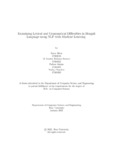| dc.contributor.advisor | Akhond, Mostafijur Rahman | |
| dc.contributor.author | Afroz, Sazia | |
| dc.contributor.author | Susmoy, M. Samiur Rahman | |
| dc.contributor.author | Anjum, Farhan | |
| dc.contributor.author | Nowshin, Nadiya | |
| dc.date.accessioned | 2021-10-18T03:07:41Z | |
| dc.date.available | 2021-10-18T03:07:41Z | |
| dc.date.copyright | 2021 | |
| dc.date.issued | 2021-01 | |
| dc.identifier.other | ID 17301023 | |
| dc.identifier.other | ID 17301155 | |
| dc.identifier.other | ID 17301184 | |
| dc.identifier.other | ID 17301192 | |
| dc.identifier.uri | http://hdl.handle.net/10361/15317 | |
| dc.description | This thesis is submitted in partial fulfillment of the requirements for the degree of Bachelor of Science in Computer Science and Engineering, 2020. | en_US |
| dc.description | Cataloged from PDF version of thesis. | |
| dc.description | Includes bibliographical references (pages 25-26). | |
| dc.description.abstract | Speech is the most relevant form of communication between individuals whereas computer systems use basic form of text or images Speech synthesis deals with the artificial production of speech, and a Speech-to-Text (STT) system in this aspect converts natural dialogue into a corresponding written language. There have been sufficient successes today in the area of speech and natural language processing that suggests that these technologies will continue to be a significant area of research and development in creating intelligent systems. In this paperwork, we are planning to provide an overview of the STT synthesis technology along with details of the phases involved. For conversion of speech the proposed model is pocketsphinx which was trained to generate an acoustic language model Additionally, our system will enable us to detect the grammatical and contextual errors of the texts. The thrust has been given to explore the usefulness of this technique in designing an STT the above system for Bangla language. This paperwork will also focus on some of the open research issues where work in this area may further be done. | en_US |
| dc.description.statementofresponsibility | Sazia Afroz | |
| dc.description.statementofresponsibility | M. Samiur Rahman Susmoy | |
| dc.description.statementofresponsibility | Farhan Anjum | |
| dc.description.statementofresponsibility | Nadiya Nowshin | |
| dc.format.extent | 26 pages | |
| dc.language.iso | en | en_US |
| dc.publisher | Brac University | en_US |
| dc.rights | Brac University theses are protected by copyright. They may be viewed from this source for any purpose, but reproduction or distribution in any format is prohibited without written permission. | |
| dc.subject | STT | en_US |
| dc.subject | NLP | en_US |
| dc.subject | HMM | en_US |
| dc.subject | PocketSphinx | en_US |
| dc.subject | Speech recognizer | en_US |
| dc.subject | Grammatical analyzer | en_US |
| dc.subject | Contextual analyzer | en_US |
| dc.subject.lcsh | Machine Learning | |
| dc.title | Examining lexical and grammatical difficulties in Bengali language using NLP with machine learning | en_US |
| dc.type | Thesis | en_US |
| dc.contributor.department | Department of Computer Science and Engineering, Brac University | |
| dc.description.degree | B. Computer Science | |

